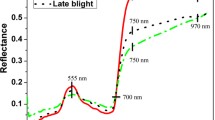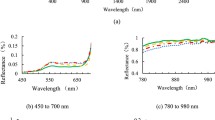Abstract
This paper investigated the possibility of discriminating tomato yellow leaf curl disease by a hyperspectral imaging technique. A hyperspecral imaging system collected hyperspectral images of both healthy and infected tomato leaves. The reflectance spectra, first derivative reflectance spectra and absolute reflectance difference spectra in the wavelength range of 500–1000 nm of both background and the leaf area were analyzed to select sensitive wavelengths and band ratios. 853 nm was selected to create a mask image for background segmentation, while 720 nm from the reflectance spectra, four peaks (560, 575, 712, and 729 nm) from the first derivative spectra and, four wavelengths with higher values (586, 720 nm) and lower values (690, 840 nm) in the absolute difference spectra were selected as a set of sensitive wavelengths. Four band ratio images (560/575, 712/729, 586/690, and 720/840 nm) were compared with four widely used vegetation indices (VIs). 24 texture features were extracted using grey level co-occurrence matrix (GLCM), respectively. The performance of each feature was evaluated by receiver operator characteristic (ROC) curve analysis. The best threshold values of each feature were calculated by Yonden’s index. Mean value of correlation (COR_MEAN) extracted from the band ratio image (720/840 nm) had the best performance, whose AUC value was 1.0. The discrimination result for a validation set based on its best threshold value was 100%. This research also demonstrated that multispectral images at 560, 575 and 720 nm have a potential for detecting tomato yellow leaf curl virus infection in field applications.












Similar content being viewed by others
References
Calderón, R., Navas-Cortés, J. A., Lucena, C., & Zarco-Tejada, P. J. (2013). High-resolution airborne hyperspectral and thermal imagery for early detection of Verticillium wilt of olive using fluorescence, temperature and narrow-band spectral indices. Remote Sensing of Environment, 139, 231–245. doi:10.1016/j.rse.2013.07.031.
Chappelle, E. W., Moon, S. K., & McMurtrey, J. E., III. The red edge shift: An explanation of its relationship to stress and the concentration of chlorophyll A. In Geoscience and remote sensing symposium, 1991. IGARSS ‘91. Remote sensing: Global monitoring for earth management, International, 3–6 Jun 1991 (Vol. 4, pp. 2287–2290). doi:10.1109/IGARSS.1991.575500.
Gamon, J. A., Peñuelas, J., & Field, C. B. (1992). A narrow-waveband spectral index that tracks diurnal changes in photosynthetic efficiency. Remote Sensing of Environment, 41(1), 35–44. doi:10.1016/0034-4257(92)90059-S.
García-Andrés, S., Accotto, G. P., Navas-Castillo, J., & Moriones, E. (2007). Founder effect, plant host, and recombination shape the emergent population of begomoviruses that cause the tomato yellow leaf curl disease in the Mediterranean basin. Virology, 359(2), 302–312. doi:10.1016/j.virol.2006.09.030.
Glick, E., Levy, Y., & Gafni, Y. (2009). The viral etiology of tomato yellow leaf curl disease-a review. Plant Protection Science, 45(3), 81–97.
Gonzalez, R. C., & Woods, R. E. (2002). Digital image processing. NJ: Prentice Hall Upper Saddle River.
Grigorescu, S. E., Petkov, N., & Kruizinga, P. (2002). Comparison of texture features based on Gabor filters. Image Processing, IEEE Transactions on, 11(10), 1160–1167. doi:10.1109/TIP.2002.804262.
Haralick, R. M., Shanmugam, K., & Dinstein, I. H. (1973). Textural features for image classification. Systems, Man and Cybernetics, IEEE Transactions on, 3(6), 610–621.
Hillnhütter, C., Mahlein, A.-K., Sikora, R. A., & Oerke, E.-C. (2012). Use of imaging spectroscopy to discriminate symptoms caused by Heterodera schachtii and Rhizoctonia solani on sugar beet. Precision Agriculture, 13(1), 17–32.
Huang, K.-Y. (2007). Application of artificial neural network for detecting Phalaenopsis seedling diseases using color and texture features. Computers and Electronics in Agriculture, 57(1), 3–11.
Hunt, E. R., Rock, B. N., & Nobel, P. S. (1987). Measurement of leaf relative water content by infrared reflectance. Remote Sensing of Environment, 22(3), 429–435.
Jones, C., Jones, J., & Lee, W. (2010). Diagnosis of bacterial spot of tomato using spectral signatures. Computers and Electronics in Agriculture, 74(2), 329–335.
Liu, Z.-Y., Shi, J.-J., Zhang, L.-W., & Huang, J.-F. (2010). Discrimination of rice panicles by hyperspectral reflectance data based on principal component analysis and support vector classification. Journal of Zhejiang University Science B, 11(1), 71–78.
Manjunath, B. S., & Ma, W.-Y. (1996). Texture features for browsing and retrieval of image data. Pattern Analysis and Machine Intelligence, IEEE Transactions on, 18(8), 837–842.
Merton, R., & Huntington, J. Early simulation of the ARIES-1 satellite sensor for multi-temporal vegetation research derived from AVIRIS. In Summaries of the Eight JPL airborne earth science workshop, 1999 (Vol. 99, pp. 299–307, Vol. 17). JPL Publication Pasadena, CA.
Penuelas, J., Filella, I., Biel, C., Serrano, L., & Save, R. (1993). The reflectance at the 950–970 nm region as an indicator of plant water status. International Journal of Remote Sensing, 14(10), 1887–1905.
Polston, J., & Sherwood, T. (2003). Pymetrozine interferes with transmission ofTomato yellow leaf curl virus by the whiteflyBemisia tabaci. Phytoparasitica, 31(5), 490–498.
Razmjooy, N., Mousavi, B. S., & Soleymani, F. (2012). A real-time mathematical computer method for potato inspection using machine vision. Computers and Mathematics with Applications, 63(1), 268–279.
Sena, D., Jr., Pinto, F., Queiroz, D., & Viana, P. (2003). Fall armyworm damaged maize plant identification using digital images. Biosystems Engineering, 85(4), 449–454.
Srinivasan, R., Riley, D., Diffie, S., Sparks, A., & Adkins, S. (2012). Whitefly population dynamics and evaluation of whitefly-transmitted Tomato yellow leaf curl virus (TYLCV)-resistant tomato genotypes as whitefly and TYLCV reservoirs. Journal of Economic Entomology, 105(4), 1447–1456.
Tellechea, M. L., Aranguren, F., Martínez-Larrad, M. T., Serrano-Ríos, M., Taverna, M. J., & Frechtel, G. D. (2009). Ability of lipid accumulation product to identify metabolic syndrome in healthy men from Buenos Aires. Diabetes Care, 32(7), e85.
Thenkabail, P. S., Smith, R. B., & De Pauw, E. (2000). Hyperspectral vegetation indices and their relationships with agricultural crop characteristics. Remote Sensing of Environment, 71(2), 158–182. doi:10.1016/S0034-4257(99)00067-X.
Unser, M., & Eden, M. (1989). Multiresolution feature extraction and selection for texture segmentation. Pattern Analysis and Machine Intelligence, IEEE Transactions on, 11(7), 717–728.
Wang, W., Li, C., Gitaitis, R., Tollner, E., Rains, G., & Yoon, S.-C. Near-infrared Hyperspectral Reflectance Imaging for Early Detection of Sour Skin Disease in Vidalia Sweet Onions. In ASABE Annual International Meeting, 2010 (Vol. 1009106). American Society of Agricultural and Biological Engineers, St. Joseph, Michigan Pittsburgh, Pennsylvania.
Wu, C.-M., Chen, Y.-C., & Hsieh, K.-S. (1992). Texture features for classification of ultrasonic liver images. Medical Imaging, IEEE Transactions on, 11(2), 141–152.
Wu, J. C., Martin, A. F., & Kacker, R. N. (2014). Bootstrap variability studies in ROC analysis on large datasets. Communications in Statistics-Simulation and Computation, 43(1), 225–236.
**ng, J., Symons, S., Shahin, M., & Hatcher, D. (2010). Detection of sprout damage in Canada Western Red Spring wheat with multiple wavebands using visible/near-infrared hyperspectral imaging. Biosystems Engineering, 106(2), 188–194.
Yang, S.-W., Lin, C.-S., Lin, S.-K., & Tseng, Y.-C. (2014). Automatic inspection system for defects of printed art tile based on texture feature analysis. Instrumentation Science and Technology, 42(1), 59–71.
Zhang, H., Gong, H., & Zhou, X. (2009). Molecular characterization and pathogenicity of tomato yellow leaf curl virus in China. Virus Genes, 39(2), 249–255.
Zhang, J.-C., Pu, R.-L., Wang, J.-H., Huang, W.-J., Yuan, L., & Luo, J.-H. (2012). Detecting powdery mildew of winter wheat using leaf level hyperspectral measurements. Computers and Electronics in Agriculture, 85, 13–23.
Acknowledgements
The authors gratefully acknowledge Dr. Xue** Zhou for providing the tomato yellow citrus leaf virus. The Department of science and Technology of Sichuan province (2017JY0144) for financial support.
Author information
Authors and Affiliations
Corresponding author
Rights and permissions
About this article
Cite this article
Lu, J., Zhou, M., Gao, Y. et al. Using hyperspectral imaging to discriminate yellow leaf curl disease in tomato leaves. Precision Agric 19, 379–394 (2018). https://doi.org/10.1007/s11119-017-9524-7
Published:
Issue Date:
DOI: https://doi.org/10.1007/s11119-017-9524-7




